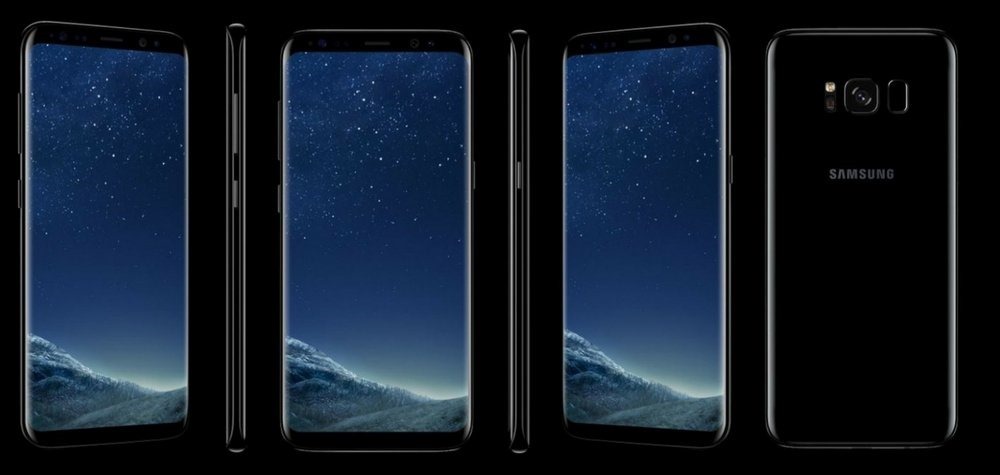Samsung Debuts Bezel-less Galaxy S8 and S8+; Launches Personal Assistant Bixby

Samsung has finally launched the much-hyped Galaxy S series’ flagship smartphones for the global market. The company has unveiled two installations – S8 and S8+ at an event in New York City on March 29.
Samsung’s S7 and S7 Edge, the previous generations, were huge sellers globally. However, the Galaxy Note 7 fiasco ended up hurting the company’s image and revenue. To defy all odds, the company has launched the flagship S8 and S8+ with a whole new design and oomph.
What makes S8 and S8+ so unique?
Both the smartphones come with infinite display, which is basically nearly bezel-less display, no physical buttons on the front and a small front camera on the top, along with sensors. However, this also means that there are no front-facing speakers.
“The Infinity Display has an incredible end-to-end screen that spills over the phone’s sides, forming a completely smooth, continuous surface with no bumps or angles. It’s pure, pristine, uninterrupted glass. The result is a beautifully curved, perfectly symmetrical, singular object,” Samsung says.
The company has inbuilt the iris scanner in these devices, exactly like the Samsung Galaxy Note 7 that was discontinued.
Galaxy S8 and S8+ Specifications
| Feature | Samsung Galaxy S8 | Samsung Galaxy S8+ |
| Display | 5.8-inch qHD+ Super AMOLED with Corning Gorilla Glass 5 | 6.2-inch qHD+ Super AMOLED with Corning Gorilla Glass 5 |
| Smartphone size | 148.9×68.1x8mm and weighs 155 grams | 159.5×73.4×8.1mm |
| Chipset | Qualcomm Snapdragon 835(2.3GHz Quad + 1.7GHz Quad) or Exynos8895 SoC (2.35GHz Quad + 1.9GHz Quad) | Qualcomm Snapdragon 835(2.3GHz Quad + 1.7GHz Quad) or Exynos8895 SoC (2.35GHz Quad + 1.9GHz Quad) |
| RAM and storage | 4GB RAM with 64GB ROM(microSD cards of upto 256GB) | 4GB RAM with 64GB ROM(microSD cards of upto 256GB) |
| Rear Camera | 12MP dual-pixel autofocus camera with flash, f/1.7 aperture and OIS | 12MP dual-pixel autofocus camera with flash, f/1.7 aperture and OIS |
| Front Camera | 8MP autofocus with f/1.7 aperture, iris scanner | 8MP autofocus with f/1.7 aperture, iris scanner |
| Battery | 3,000mAh | 3,500mAh |
| Bluetooth and LTE | Bluetooth 5.0 and LTE ready | Bluetooth 5.0 and LTE ready |
| Other connectivity options | USB Type-C, NFC, heart rate sensor, magnetometer, fingerprint sensor | USB Type-C, NFC, heart rate sensor, magnetometer, fingerprint sensor |
From the looks of it, the smartphone has all the top-of-the-line specs with the latest Qualcomm Snapdragon 835 chipset for the US and Exynos chipset for other countries, including India. The only difference between the two smartphones is the screen size and battery content.
Pricing wise, Samsung is going to retail S8 in the US for $750, nearly as much as Pixel, and S8+ for $850. This means India could see a retail price of roughly Rs. 55,000 and Rs. 62,000 respectively.
S8 and S8+ dimensions compared to other smartphones
Samsung Galaxy S8 has tiny dimensions because of the screen estate, and since the company claims it has an infinite panel, we wanted to see how good it compares to other phones, considering most of them lie in the 5.5-inch to 6-inch range.
S8 has 148.9 x 68.1 x 8 mm with a 5.8-inch screen, and let’s set this as a benchmark. Google Nexus 6P has dimensions of 159.3 x 77.8 x 7.3 mm with a 5.7-inch display, almost 10mm longer and 10mm wider. Nexus 6P has huge chins on the top and below and it shows.
Google Pixel has dimensions of 154.7 x 75.7 x 8.5 mm with a 5.5-inch display, almost 6mm longer and 7mm wider. iPhone 7 Plus has the hugest bezels with dimensions of 158.2 x 77.9 x 7.3 mm, comparable to that of Nexus 6P but with a smaller screen of 5.5-inch.
Now, the main competitor has to be the LG G6, newly launched phone with a 18:9 aspect ratio. It stands at 148.9 x 71.9 x 7.9 mm with a 5.7-inch display, which means it is of the same height as S8 but with more width. Of course Samsung takes advantage of the curved display at the end, so both the phones have nearly similar footprint.
Samsung Galaxy S8 and S8+ look like fantastic phones and we’re excited to see them on Indian shores competing with the likes of iPhone 7 Plus, LG G6 and Google Pixel XL.
Source: Samsung
